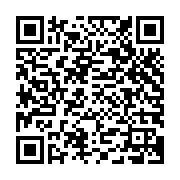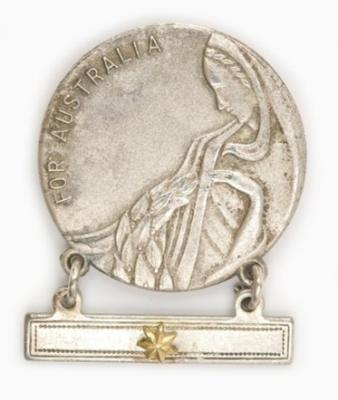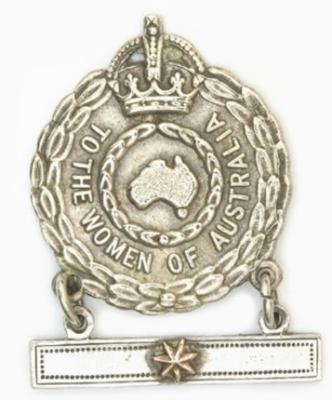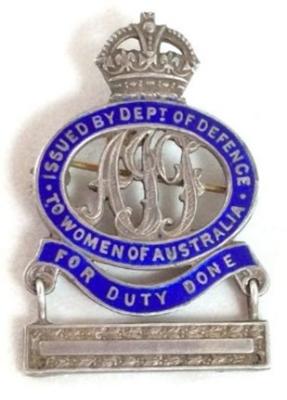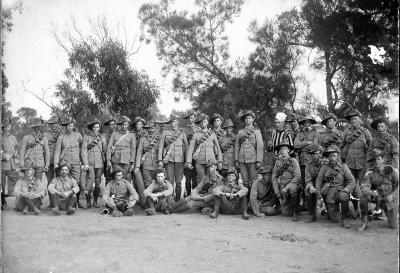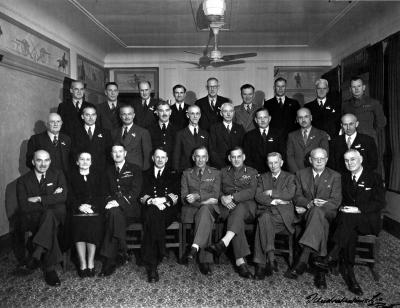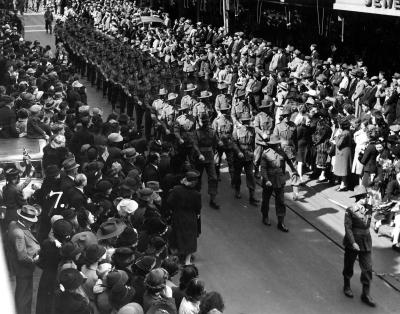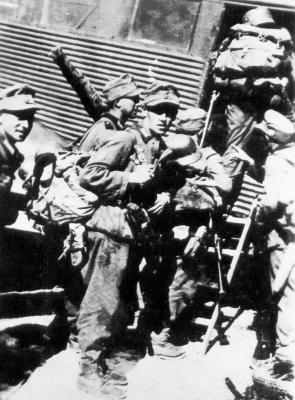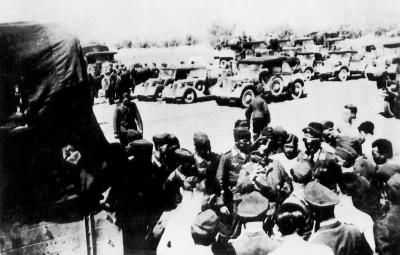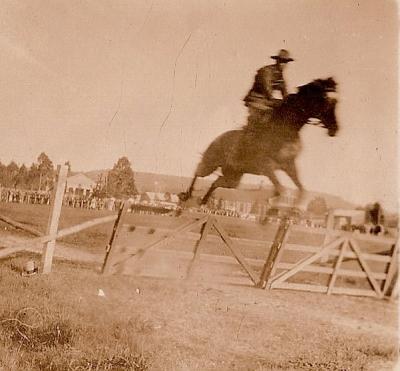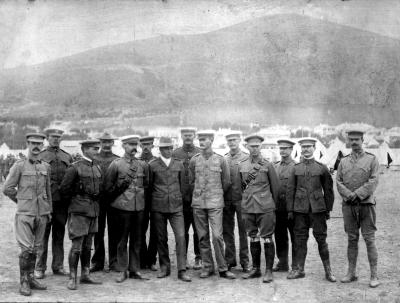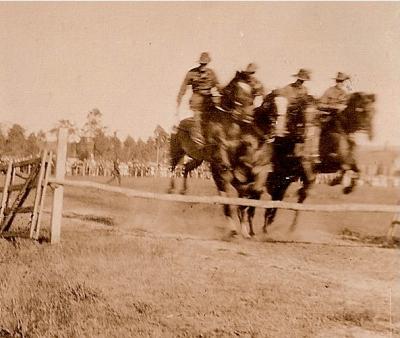16th Battalion (The Cameron Highlanders of Western Australia) - King's Colour (1951 Presentation)
Union flag with gold fringe. In the centre the Arabic numeral "16" on a red background within a circle inscribed "SIXTEENTH BATTALION", surmounted by the Crown.
Emblazoned on the colour are the following Second World War Battle Honours:-
NORTH AFICA 1941, SYRIAN FRONTIER, THE LITANI, SIDON, WADI ZEINI, DAMOUR, KOKODA TRAIL, BUNA-GONA, LIBERATION OF AUSTRALIAN NEW GUINEA, BORNEO
With the re-activation of the Citizen Military Forces (CMF) following the Second World War, the 16th/28th Infantry Battalion (The Cameron Highlanders of Western Australia) was raised in 1948 to carry on the identity and traditions of the pre-war 16th and 28th Battalions respectively. The King's and Regimental Colours formerly held by these two battalions were passed on to the new battalion who paraded them in rotation on ceremonial occasions
It was decided in 1950 that a new set of Colours would be presented to 16th Battalion. For reasons that still remain unclear, these were manufactured under local arrangement by "cannibalising" the original 1933 set of colours and transferring the devices and battle honours (in the case of the Regimental Colour) to the new Colours. (Reported by Western Command to the Adjutant General -reference file A 107/1/11 dated 30 April 1952). These new colours were presented by Major-General JS Whitelaw, CB, CBE at a parade of the 16th/28th Infantry Battalion held on the Esplanade, Perth, 26 August 1951.
(For details of Colours previously presented to 16th Battalion see separate section below).
16th/28th Infantry Battalion became unlinked in March 1952 with both 16th and 28th becoming independent battalions within their own right.
With the accession of HM Queen Elizabeth II to the throne in 1953, all Colours that had originally been presented as King's Colours, and were still carried by units on the current Order of Battle, were automatically deemed to be Queen's Colours.
Under major reorganisation of the CMF in 1960, all individual infantry battalions that existed at the time within each State were amalgamated to form State regiments, taking effect from 1 July 1960. Thus from that date the 11/44th, 16th and 28th Infantry Battalions were amalgamated to form The Royal Western Australia Regiment. In September 1960, at a ceremonial parade held at Northam Camp, the Colours carried by all former battalions were handed over for safe keeping by the new regiment.
Battle Honours for the Second World War were promulgated under Australian Army Order 135/1961 and the 10 selected honours approved for emblazoning on the Queen's Colour were subsequently added in 1962
These former colours were subsequently laid up in the undercroft at the State War Memorial, King's Park on 29 November 1964. These were transferred to the Army Museum of WA in 1988 as part of the Bicentenary Colours Project
Details
Details
Notwithstanding the monarch at the time of presentation, the Primary Colour of an infantry battalion is referred to according to the reigning monarch. Hence all former Queen’s Colours became as a matter of protocol, King’s Colours on the accession of King Charles III on 8 September 2022.
Previous Colours presented to 16th Battalion
The designation "16th" was allocated to several different infantry battalions that had been raised at different stages during changes to organisational structure of the Citizen Forces during the 1920's and 1930's.
The original King's Colour awarded for service of 16th Battalion (AIF) and received in 1920 by the Citizen Force unit 2nd Battalion, 16th Infantry Regiment was later passed on to 16th Battalion (The Goldfields Regiment) which had been raised in the Kalgoorlie area in 1921. This unit became inactive and this Colour was later laid up in the Kalgoorlie Council Chambers.
In order to maintain the identity of 16th Battalion as a Citizen Force unit, in 1930 11th Battalion (The Perth Regiment) was reformed as a linked battalion under the designation 11th/16th Battalion. As the 11th Battalion had already received its set of colours in the 1920's, it was decided that a set of King's and Regimental Colours be presented for 16th Battalion. These were presented by HE the Lieutenant-Governor Sir James Mitchell, KCMG at a parade of 11th/16th Battalion held at Perth Oval on 15 October 1933. The colours were consecrated by the Chaplain General, Archbishop COL Riley, OBE, VD, DD.
In 1936 16th Battalion was re-established as a separate battalion within its own right, being formed as 16th Battalion (The Cameron Highlanders of Western Australia). The colours presented in 1933 were passed on to this new battalion and were also initially carried by the post-World War Two unit 16th/28th Infantry Battalion (The Cameron Highlanders of Western Australia) as already mentioned.
Open in Google Maps
Nearest geotagged records:
- 10 Light Horse Regiment - Guidon (1928 Presentation) (0km away)
- 11th Battalion (The City of Perth Regiment) - King's Colour (1920 Presentation) (0km away)
- 11th Battalion (The City of Perth Regiment) - Regimental Colour (1929 Presentation) (0km away)
- 1st Battalion, 11th Australian Infantry Regiment (Perth Regiment) - King's Banner (1911 Presentation) (0km away)
- 16th Battalion (The Cameron Highlanders of Western Australia) - Regimental Colour (1952 Presentation) (0km away)
- 44th Battalion (The West Australian Rifles) - King's Colour (Initial Presentation 1920) (0km away)
- 44th Battalion (The West Australian Rifles) - Regimental Colour (1927 Presentation) (0km away)
- 16th Battalion, The Royal Western Australia Regiment - Regimental Colour (1962 Presentation) (0km away)
- General Gordon Bennett's office desk, Perth College, 1942 (0km away)
- Vietnam Era, Australia, Western Australia, Fremantle, Artillery Barracks, 1969 (0km away)
Nearby places: View all geotagged records »
Australian Army Museum of Western Australia
Australian Army Museum of Western Australia
Other items from Australian Army Museum of Western Australia
- Mothers’ and Widows’ Badge – World War 1
- Mother's and Widow's Badge – World War 2
- Female Relative Badge World War 2
- Female Relative Badge World War 1
- World War 1, Guildford, Western Australia, Australia, Australian Field Artillery, 1914
- Post-War, Swan Barracks, Western Australia, Australia, LE LE SOUEFF
- World War 2, Western Australia, Perth, 2/11 Battalion, 1940
- World War 2, Eastern Mediterranean, Crete, German troops
- World War 2, GOERING, Luftwaffe
- Inter-War, Western Australia, Harvey, 10 Light Horse, 1926
- Pre 1914, 2nd Anglo Boer War, Cape Town, South Africa, 5th and 6th Western Australian Mounted Infantry
- Inter War, Western Australia, Harvey, 10 Light Horse, 1926
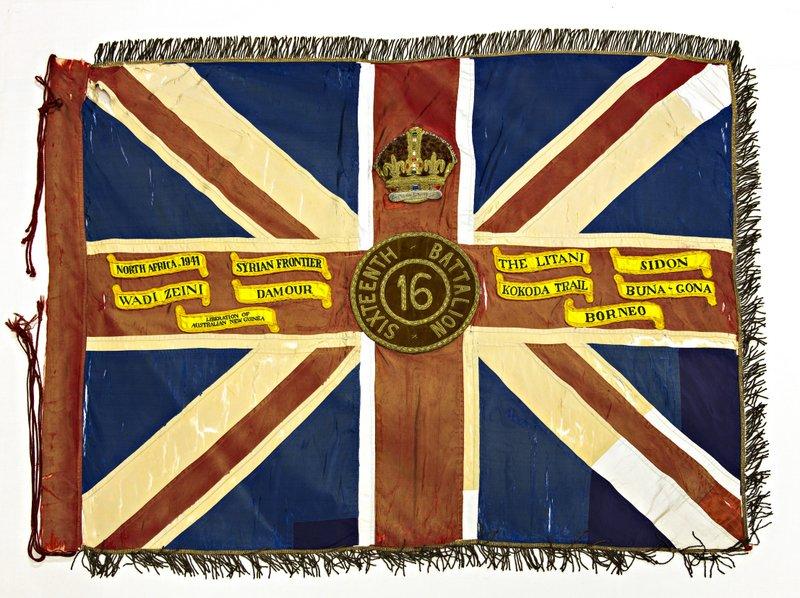

Scan this QR code to open this page on your phone ->
